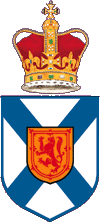BILL NO. 56
(as introduced)

5th Session, 61st General Assembly
Nova Scotia
62 Elizabeth II, 2013
Cyberbullying Intervention Act
Allan MacMaster
Inverness

5th Session, 61st General Assembly
Nova Scotia
62 Elizabeth II, 2013
Allan MacMaster
Inverness
First Reading: April 23, 2013
Second Reading:
Third Reading:
WHEREAS parents and guardians have a moral and legal duty to take responsibility for the Internet use of their children;
THEREFORE be it enacted by the Governor and Assembly as follows:
1 This Act may be cited as the Cyberbullying Intervention Act.
(a) "cyberbully" means to use the Internet or any other form of electronic communication, including social media, emails and text messages, deliberately or recklessly, to cause, directly or indirectly, harm to another person;
(b) "harm" means physical or emotional harm to a person that would also harm a reasonable person in those circumstances;
(c) "reasonable notice" means, unless a court orders otherwise,
(ii) where an application is made outside of an existing proceeding, five days;
(e) "youth" means a person under the age of eighteen years;
(f) "youth justice court" has the same meaning as in the Youth Justice Act.
3 (1) Any person who cyberbullies a youth is guilty of an offence.
(2) Any person who fails to comply with an order made under this Act is guilty of an offence.
4 Where a youth uses an electronic device to commit an offence under this Act, the youth's parent or guardian
(a) commits an offence under this Act; and
(b) is jointly and severally liable for any injury or loss suffered by any other person for which the youth is held civilly liable,
(c) the parent or guardian had been warned that the youth was suspected of cyberbullying; or
(d) the parent or guardian knew or ought to have known the youth was cyberbullying.
5 In a prosecution for an offence under Section 4, it is a defence for the person charged to prove that the person has exercised due diligence to prevent the youth from committing an offence.
6 Section 4 of the Summary Proceedings Act does not apply to this Act.
7 (1) Upon application made in writing served with reasonable notice upon a person, whether within the context of a legal proceeding at any stage or otherwise, a judge of the Provincial Court or of the youth justice court may order that the use by the person of any electronic device or devices be restricted or prohibited for any period of time to prevent cyberbullying if it is in the public interest to make such an order.
(2) An order made pursuant to subsection (1) may include
(a) a provision confiscating temporarily or forfeiting permanently any electronic device, even if owned by a parent or guardian of the person, upon such terms as the court determines;
(b) a provision suspending or terminating any account with an electronic service provider, if the account-holder and the service provider have been given a reasonable opportunity to be heard; and
8 Reasonable notice of an application made pursuant to Section 7 must, where possible, be served upon a parent or guardian of any youth about whom such an application is made.
9 (1) At any stage in a proceeding prior to the entry of a plea, the informant or a member of the public prosecution service may, by agreement with a youth about whom an information has been sworn or would otherwise be sworn, refer that youth to complete such alternative measures as are prescribed by the regulations.
(2) At any stage in a proceeding, including an application made pursuant to Section 7, a court may order a youth charged with an offence to complete such alternative measures as the court considers appropriate, but no such referral may be made without the consent of the accused prior to a finding of guilt.
10 Alternative measures may be ordered instead of or in addition to a sentence, but successful completion of alternative measures must be taken into account in determining the rest of a sentence and sentencing may be adjourned after the making of an order for alternative measures in order to determine the outcome thereof.
11 Alternative measures must, where reasonably possible, focus on
(a) causing a youth to understand the gravity of what the youth has done and to change the youth's behaviour;
(c) restoring the victim of cyberbullying, including restitution for any costs the victim or the victim's family has incurred;
(d) educating members of the community on the perils of cyberbullying, recognizing that the community may be a geographic area or online or both; and
(e) restoring the community to which the youth and the victim belong.
12 Any passage of time between the time a youth is offered alternative measures and the time the public prosecution service or the investigating police officer is notified that alternative measures have not been successfully completed are not counted in determining an applicable limitation period.
13 (1) Any person 18 years of age or older convicted of an offence under this Act is liable
(a) for a first offence, to a fine not exceeding $1,000; or
(b) for a second or subsequent offence, to a fine not exceeding $2,500 dollars.
(2) Any person under the age of 18 years convicted of an offence under this Act is liable
14 In addition to an penalty imposed for a conviction under this Act, the judge shall consider and may make an order pursuant to Section 7.
15 (1) The Governor in Council may make regulations prescribing alternative measures for the purpose of Section 9.
(2) The exercise by the Governor in Council of the authority contained in subsection (1) is a regulation within the meaning of the Regulations Act.